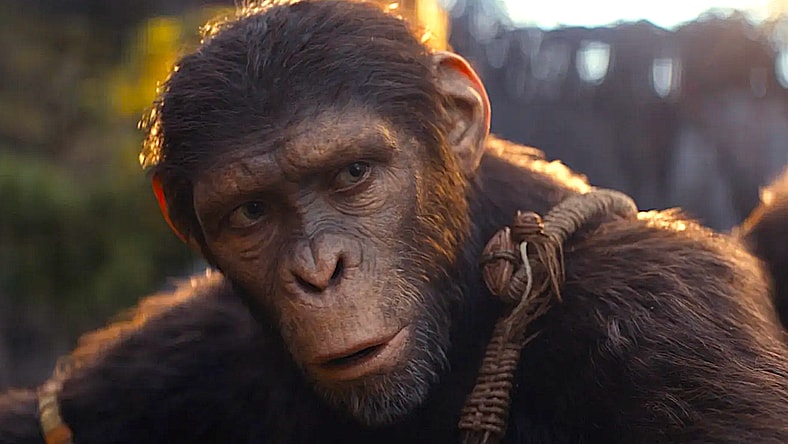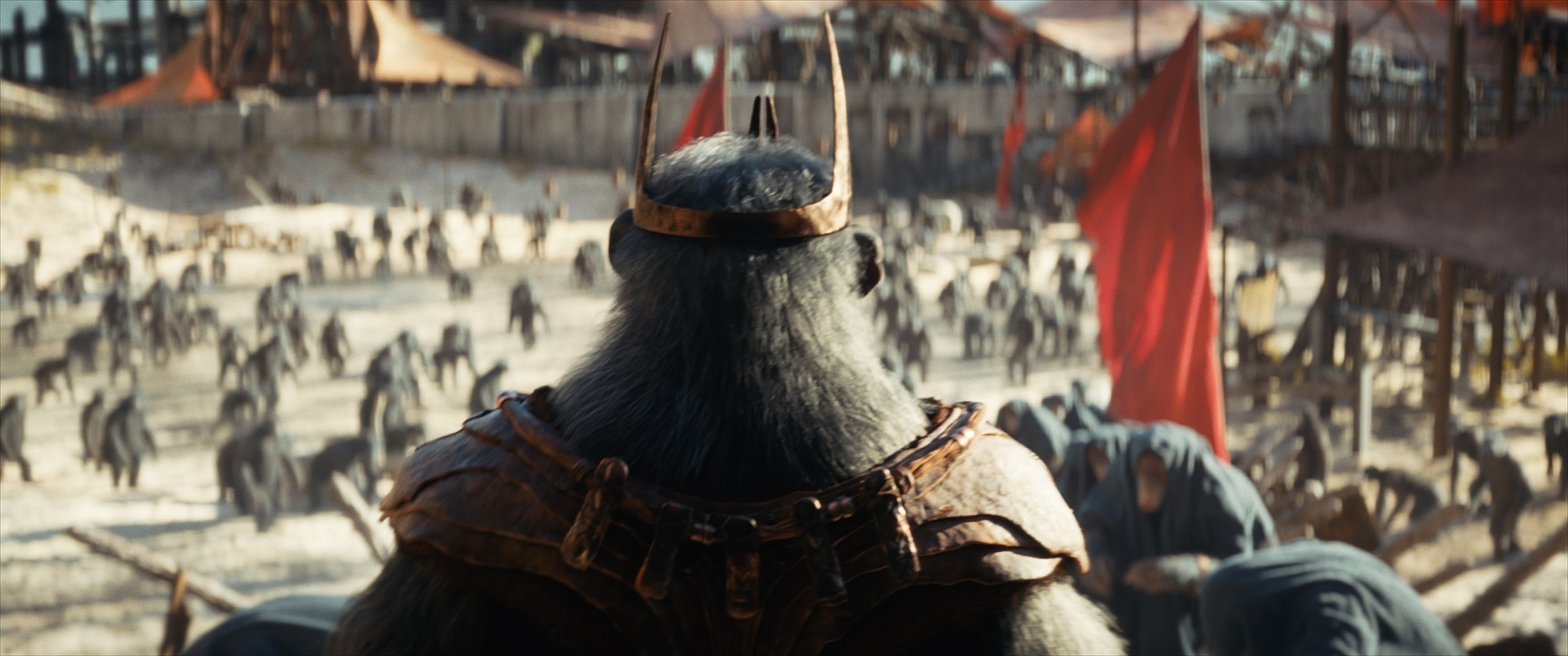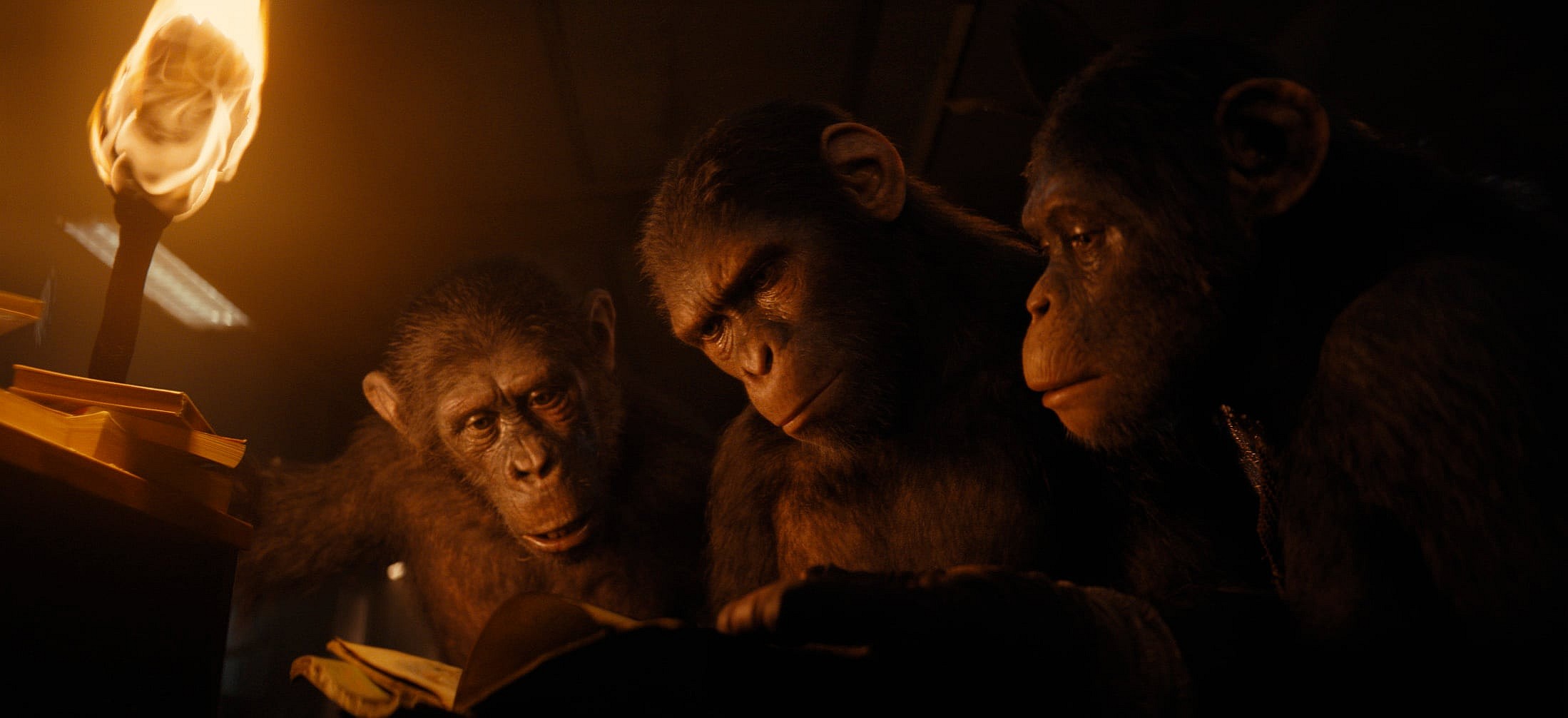‘Kingdom Of The Planet Of The Apes’ Review – A Dawdling Visual Masterpiece

The Caesar trilogy of the Planet of the Apes films (2011-2017) has a fair share of homage and references to the original movies. Still, Kingdom of the Planet of the Apes is heavily rooted in several of the previous films.
Despite the fact that Kingdom takes place nearly 300 years after the events of War for the Planet of the Apes, Caesar’s legacy lives on. His contributions to ape society are still just as relevant.

Naturally, revisiting Rise of the Planet of the Apes, Dawn of the Planet of the Apes, and War for the Planet of the Apes before seeing Kingdom of the Planet of the Apes is a must.
Surprisingly, though, Kingdom borrows a lot from the original 1968 film. Humanoid scarecrows from the Forbidden Zone, music cues from the original score respectfully borrowed, the talking doll found in the cave, humans being hunted by apes on horseback, and a mute human female being referred to as Nova are a few examples.

Even without humans, Noa’s village feels like a direct reference to what Caesar had built in Battle for the Planet of the Apes. If you have the time to watch five films (the Caesar trilogy, the original, and Battle) before seeing Kingdom, you’ll appreciate all the little Easter eggs more.
Written by Josh Friedman (who has story writing credits on Terminator: Dark Fate and Avatar: The Way of Water), Kingdom of the Planet of the Apes follows Noa (Owen Teague) as he and his friends Soona (Lydia Peckham) and Anaya (Travis Jeffery) as they hunt for eagle eggs. Noa’s tribe raises and trains eagles, and a bonding ceremony will soon occur.

But after Noa’s egg is compromised, he leaves alone to find a replacement. Another clan, led by Proximus Caesar (Kevin Durand), has mangled Caesar’s teachings for Proximus’ gain. Noa’s outing leads Proximus’ clan back to his village.
Noa is left unconscious after the encounter, only to awaken to his village in shambles and his clan gone. He sets out to reunite with the survivors and, hopefully, rebuild his home.

Visual effects and CGI have come a long way in the seven years since War for the Planet of the Apes. When revisiting Rise of the Planet of the Apes, the VFX are solid for a film that came out in 2011 but still noticeably dated. By today’s standards, War still looks incredible for a 7-year-old film.
With VFX still being handled by Weta FX and visual effects supervisor Erik Winquist, the team that dealt with the entire Caesar Apes trilogy, Kingdom is a masterpiece for the eyes. The most distinguishable difference is facial expressions.
Erik Winquist and Weta made use of the same technology they used while working on Avatar: The Way of Water for this film, and performance capture has become much more intricate in the past six years.
Like the previous Apes films and The Mandalorian, Kingdom was filmed on location while utilizing full CGI. The apes interact with water in two big sequences in the film: a human hunt and the flood inside the bunker.
Two of the most difficult things to render digitally are water simulations and hair. From an utterly visual standpoint, Kingdom of the Planet of the Apes is flawless.
Josh Friedman’s writing is where the film slips. Despite being somewhat similar to Koba in the Caesar films, Proximus is a fantastic villain thanks to Kevin Durand’s performance; boisterous, theatrical, and dangerously unpredictable. His intentions as an ape are sinister, and his character’s fate tying into Julius Caesar is genius.

However, much of the film focuses on wandering around. There’s a reason for this like Frodo and Sam walking forever to take The One Ring to Mordor in Lord of the Rings. While there are exciting sequences in Kingdom, the travel and the dialogue regarding their intended plans take precedence over something that could be even more thrilling.
Wes Ball has stated that Kingdom should be the beginning of a new trilogy of Planet of the Apes films. He wants the trilogy’s final film to return to the original Planet of the Apes. In previous Apes films, the main protagonist was powerfully written and given a memorable performance.

The original film had Charlton Heston, the later films had Roddy McDowall, and the newer Apes films had Andy Serkis as Caesar. If Noa is supposed to be the new Caesar, which seems like the intention, given the same scar on his chest and his position by the end of the film, then Noa sucks as a main character.
He is young and weak, while Owen Teague’s performance is somewhat timid at first but slowly evolves into something competent. In contrast, Caesar was more intelligent than the average ape, but Noa seems clumsier and whinier than the average ape while falling off of things at every opportunity. And maybe that’s the point: Noa grows into his own while learning who Caesar was.

Kingdom of the Planet of the Apes has beautiful cinematography, mostly compelling performances from the cast, and superb performance capture that’s more impressive than ever. As the Planet of the Apes films progress, it’s remarkable how connected they all are. Most sequels or reboots will ignore certain installments or start all over.
All of the Planet of the Apes films feel relevant here except for the Tim Burton remake from 2001 starring Mark Wahlberg. Visually, Kingdom of the Planet of the Apes is perfect. From an entertainment perspective, it drags more than it delivers.
NEXT: ‘The Roundup: Punishment’ Review – Action That Packs An Arsenal Of Punches
Kingdom of the Planet of the Apes (2024), 20th Century Studios
PROS
- Unbelievable VFX.
- The water sequences.
CONS
- Is really slow at times.
